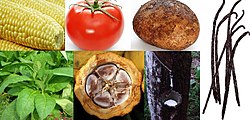| Part of a series on |
| World trade |
|---|
 |
This is a timeline of the history of international trade which chronicles notable events that have affected the trade between various countries.
Contents
- Chronology of events
- Ancient
- Classical
- Medieval
- Early modern
- Later modern
- Post-World War II
- See also
- Notes
- References
- Citations
- Bibliography
- Citated books
- External links
In the era before the rise of the nation state, the term 'international' trade cannot be literally applied, but simply means trade over long distances; the sort of movement in goods which would represent international trade in the modern world.







